Posts Tagged ‘Totem’
Totem
A ball flower paper-cut “Baby with coiled hair” is very popular among the 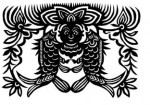 folks on the loess plateau along the Yellow River basin. In the center of the ball is this baby with coiled hair, who is patron saint and god of propagation on loess plateau. Wearing a hair style with double coils upward to the sky, and holding a pair of fish in both arms, she assumes a squatting posture as if giving birth. The lower part of her body is a pair of scissors pointing downward to imply the nature of male or yang, which, corresponding with her hair coils implies that she is hermaphroditic god of the universe. Scissors is yang by nature, a sharp tool that keeps away evil spirits and disasters. As a folk proverb goes: “Awl and scissors drive away the five poisonous creatures.” Some folk art works make the eyes of god as the sun. The two breasts are the two eyes of a cicada, a legendary animal of propagation, to symbolize a continued and never ending posterity. On each side are symbols of “Sheng” (A music instrument, hegemony of “birth” in Chinese), or lotus flowers. “Sheng” is “birth” and lotus is a proliferous symbol with male nature. A local folk proverb goes: “When lotus and sweet osmanthus growing out of a bucket, we have sons, daughters and nephews; when golden cicada blowing ‘Sheng,’ family posterity never ends.” “A ripe persimmon bears eight precious ‘Sheng (kids),’ and a lotus plants the seeds.” In this art work, god of the universe holds yin and yang two fish, one in each hand, with their tails connecting in a continuous letter “Wan” without breaking up, implying a never ending prosperity and continued posterity. In the lower part of the picture are two geometry symbols of Ruyi (good luck), and a legendary rabbit holding grass in the mouth. Rabbit, hegemony of “spit kids”, is god of proliferation. Two rabbits with double Ruyi have the meaning of giving birth to precious sons one after another. A wedding song used by the people of the loess plateau has “double walnuts and double jujubes, double sons and daughters chasing around. A good son is expected to grow up wearing cap and blue gown (to become an official); and a daughter is to be capable with her hands.” With the art of paper-cut, “every cut has a meaning of its own” said the grandmother who made this art work of multi-lateral, collective symbols and cultural codes with the theme of life and propagation. If a paper-cut for window decoration could be a tourist book of northern Shaanxi, “Baby with coiled hair” would be an orchestra of the paper-cut art. It is actually a transformed version of “Double fish with human faces” on 600-year-old painted pottery from the Yangshao culture of Xi’an.
folks on the loess plateau along the Yellow River basin. In the center of the ball is this baby with coiled hair, who is patron saint and god of propagation on loess plateau. Wearing a hair style with double coils upward to the sky, and holding a pair of fish in both arms, she assumes a squatting posture as if giving birth. The lower part of her body is a pair of scissors pointing downward to imply the nature of male or yang, which, corresponding with her hair coils implies that she is hermaphroditic god of the universe. Scissors is yang by nature, a sharp tool that keeps away evil spirits and disasters. As a folk proverb goes: “Awl and scissors drive away the five poisonous creatures.” Some folk art works make the eyes of god as the sun. The two breasts are the two eyes of a cicada, a legendary animal of propagation, to symbolize a continued and never ending posterity. On each side are symbols of “Sheng” (A music instrument, hegemony of “birth” in Chinese), or lotus flowers. “Sheng” is “birth” and lotus is a proliferous symbol with male nature. A local folk proverb goes: “When lotus and sweet osmanthus growing out of a bucket, we have sons, daughters and nephews; when golden cicada blowing ‘Sheng,’ family posterity never ends.” “A ripe persimmon bears eight precious ‘Sheng (kids),’ and a lotus plants the seeds.” In this art work, god of the universe holds yin and yang two fish, one in each hand, with their tails connecting in a continuous letter “Wan” without breaking up, implying a never ending prosperity and continued posterity. In the lower part of the picture are two geometry symbols of Ruyi (good luck), and a legendary rabbit holding grass in the mouth. Rabbit, hegemony of “spit kids”, is god of proliferation. Two rabbits with double Ruyi have the meaning of giving birth to precious sons one after another. A wedding song used by the people of the loess plateau has “double walnuts and double jujubes, double sons and daughters chasing around. A good son is expected to grow up wearing cap and blue gown (to become an official); and a daughter is to be capable with her hands.” With the art of paper-cut, “every cut has a meaning of its own” said the grandmother who made this art work of multi-lateral, collective symbols and cultural codes with the theme of life and propagation. If a paper-cut for window decoration could be a tourist book of northern Shaanxi, “Baby with coiled hair” would be an orchestra of the paper-cut art. It is actually a transformed version of “Double fish with human faces” on 600-year-old painted pottery from the Yangshao culture of Xi’an.
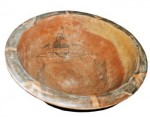 Paper-cut “paired fish dolls” from the loess plateau of Gansu Province has two yin-yang fish one on each side. It shares the same cultural implication and art form as “Yinyang fish,” and “Baby with coiled hair.” In Luochuan, Shaanxi Province, it is in the form of a paired snake with coiled hair, and paired dragon with coiled hair. In Chinese folk art, fish, snake (dragon) and baby girl are related and interchangeable.
Paper-cut “paired fish dolls” from the loess plateau of Gansu Province has two yin-yang fish one on each side. It shares the same cultural implication and art form as “Yinyang fish,” and “Baby with coiled hair.” In Luochuan, Shaanxi Province, it is in the form of a paired snake with coiled hair, and paired dragon with coiled hair. In Chinese folk art, fish, snake (dragon) and baby girl are related and interchangeable.
Paired of fish with human faces on painted pottery from Banpo –In Shaanxi, Shanxi and Gansu area, a similar image as “Baby with coiled hair” is the “Paired fish with human faces” on painted pottery from Yangshao culture of 6000 years ago unearthed in Banpo of Shaanxi. People tend to connect this with the fishing and hunting life style of primitive society. As some argued, the sketches on each side were symbols of a fish net. The painting showed only the heads, the interpretation went on as: two fish nets were set open, and two people were in the water. Their feet being in the water were left out. It was implied that their hands were busy catching fish under the water. By closing in from two opposite sides, they made the fish running into the net. Their half closed eyes were a sub-conscious facial look when focused on catching fish. (Quote from My humble opinion on a few painted potteries. Central China Culture Relics 1987-1). In my opinion, the creators of the art work in primitive society always tried to convey the original Chinese philosophy through cultural symbols and codes that were accepted by the community. Without the knowledge of original Chinese philosophy, it would be impossible to decode their symbols, nor to interpret Chinese archaeology art or folk art. Take fish for example, the paired fish created in the art work was not the fish in their natural being. It was yin-yang fish symbols. The two fish on painted pottery rotating towards opposite direction were yin-yang fish revolving around the sky, a conceptual symbol of perpetual life.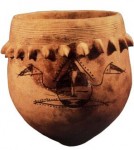
Paired fish with human faces in folk art – Corresponding with paper-cut “Yinyang fish” and “Baby with coiled hair,” “Paired fish with human face” on painted pottery symbolizes the first ancestor, god of the universe. Looking at this image, god has one eye open (from the human face on painted pottery unearthed at Jiang Village), and the other eye closed (from the human face on painted pottery unearthed at Banpo). Apparently, they are not the natural but conceptual eyes. With god of the universe, the open eye is the sun, the day and yang; the closed eye is the moon, the night, and yin. It is common practice in Chinese folk art to liken eye to the sun and the moon. In folk art painting created by the wives in northern Shaanxi, all human faces are round-eyed, same as the eyes of the tiger. Their eye balls are always in the center of the white unsheltered by eye lids. It is believed that a closed eye is the moon and an open eye is the sun. Therefore, eyes should be painted bright and shining. To me, that might also be a cultural comprehension from the primitive clans.
Symbols of Visual Objects
The art form of Chinese folk art is the visual image of the objects in the 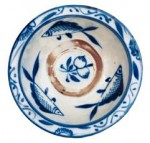 universe, according to the original Chinese philosophy.
universe, according to the original Chinese philosophy.
In primitive society, human was on the weak side in the struggle against natural disasters. Animals with superman capability became supernatural or totem animals in the eyes of humans, for example, polygenetic animals like fish, toad and frog were regarded as female totem symbols from mother’s body of earth and water; animals that were difficult to conquer such as snake, tiger, ox, boar, bear, or with special capability such as flying birds and butterflies; or that ran fast on mountain peaks and precipices like antelope; were male totem symbols, same as the sky and the sun. Over the course of several thousand years, these symbols have been, and still are, used by people of various national background and geographical areas in their respective regional folk art.
In the prairie areas of northern China, the deer totem symbol worshipped by the people in remote antiquity is still a symbol in today’s folk art of the prairie culture; and the pig and the dragon totem from Hongshan culture originated in primitive society in Liaohe basin are still the upper stream 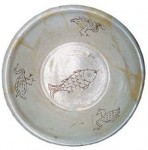 Yangtze River. Regional totem symbols still prevail in today’s folk art.
Yangtze River. Regional totem symbols still prevail in today’s folk art.
In ancient China, people connected natural animals with the sky and earth, and with the theory of yin-yang. Animals in the yang group symbolized the sky and the sun. The unification of “yang” animal from the sky with “yin” animals of earth meant a connection of the sky and earth, or the unity of yinyang. Among Chinese totem animals and legendary animals, the tiger, the ox, the goat, the bird, the bear, the boar, the dog and the cock were of the sky and yang group; the dragon, the snake, the turtle, the fish and the frog were yin group and symbols of earth and water. The dragon, with his head on earth but mating in heaven, was a totem of both worlds (Dragon was originally earth and water animal, but later went to heaven to become the king, and phoenix, an animal in heaven was the queen.) This is rather unique. For example, dragon, being an earth and water totem symbol, later became a cultural symbol of the entire nation in the confluence of multiple national cultures. People integrated the dragon into their own totem animal which turned into the dragon with a boar head in Liaohe basin; or the dragon with a tiger head in the middle-upper stream of the Yellow River; the dragon with a bird head in middle-lower stream of the Yellow River and the Yangtze River; and the dragon with an ox head in middle-upper stream of the Yangtze River. It is also quite common to see “fish with a tiger head” or “fish with a cock head” in Chinese folk art. When two animals are combined into one, it was a cultural symbol that  heaven and earth connect, male and female mate. Other example like “cock holding a fish in the mouth” and “bird holding a fish in the mouth” also implied the connection of heaven and earth, yin and yang. It was a cultural code originated in the communal philosophy in primitive society.
heaven and earth connect, male and female mate. Other example like “cock holding a fish in the mouth” and “bird holding a fish in the mouth” also implied the connection of heaven and earth, yin and yang. It was a cultural code originated in the communal philosophy in primitive society.